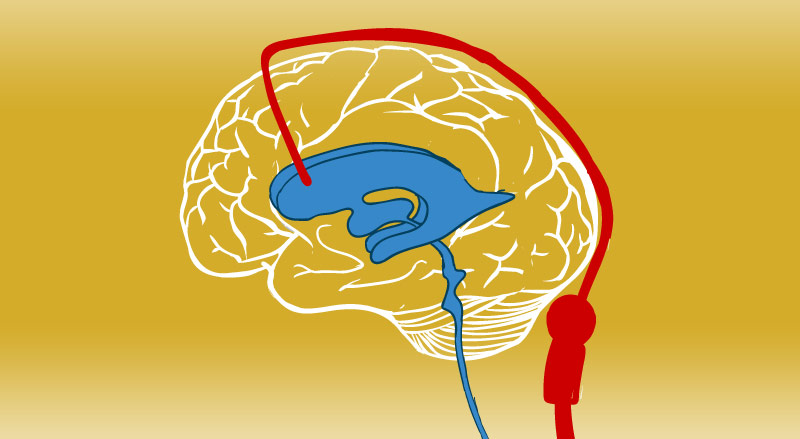
Fluid — also known as cerebrospinal fluid or “CSF” — provides cushion and protection around the  brain. If too much fluid builds up in the brain, it can cause brain damage and lead to serious problems for your child’s health. If left untreated, this fluid can be life-threatening.
brain. If too much fluid builds up in the brain, it can cause brain damage and lead to serious problems for your child’s health. If left untreated, this fluid can be life-threatening.
A ventriculoperitoneal (VP) shunt may be placed to help drain the fluid out of the brain.
A VP shunt is a long plastic tube (catheter) that drains the fluid from your child’s brain to the lining of their abdomen, called the peritoneum. A valve, which is connected to the catheter, is placed behind your child’s ear. When excess fluid puts pressure on the valve, it opens to drain the fluid to their abdomen, where it gets absorbed.
A VP shunt can be programmable or non-programmable. It’s very important to know which type of shunt your child has. If a shunt is programmable, the neurosurgeon can adjust the amount of fluid it drains from the brain, even after it has been placed. Non-programmable shunts can’t be adjusted without additional surgery.
Potential risks and complications of a shunt include:
- Shunt malfunction
- Shunt infection
- Bleeding
- Brain damage
- Injury to structures inside of the abdomen from the catheter
- Need for replacement or repositioning of shunt
Make An Appointment
Phone 402-955-3950 | Fax 402-955-3972
Living With A VP Shunt
It’s important to ask your child’s neurosurgeon for more information about what precautions to take with your child’s shunt.
While manufacturer guidelines vary depending on the type of shunt, in general:
- The settings of some programmable shunts may change if your child comes too close to a magnet. If your child has a magnetic resonance imaging (MRI) test, the shunt may need to be reprogrammed. If the shunt is not reprogrammed, it could hurt your child.
- Before your child has an MRI, make sure arrangements have been made with your child’s neurosurgeon to have the shunt reprogrammed within 4 hours after the MRI. You don’t need to take any precautions if your child is having a computed tomography (CT) scan or x-ray.
- If your child needs abdominal surgery, tell the doctor doing the surgery that your child has a shunt. You should also inform your child’s neurosurgeon before the surgery.
- Discuss the safety of contact sports with your child’s neurosurgeon before your child starts or continues playing them.
- Keep your child’s shunt information card with you at all times.
- Consider sharing this teaching sheet with your child’s school teacher and school nurse.
VP Shunt Wound Care
After a shunt is placed, special precautions and care are needed to help your child avoid infection or complications. When caring for your child’s shunt:
- Do not soak the incision/wound in water for 6 weeks after surgery.
- Do not submerge the wound under water until your child’s provider says it is okay to do so. This means not taking a bath or shower, going swimming, or using a hot tub. Instead, give your child a sponge bath and wash their hair every day.
- Make sure you know how to clean and care for your child’s incisions before leaving the hospital. Ask your child’s nurse to show you how to do this.
Shunt Malfunctions And Infections: When To Seek Medical Attention
Call your child’s neurosurgeon right away if your child has symptoms of shunt malfunction or shunt infection.
If you are unable to speak with the neurosurgeon, go to the Emergency Department. A shunt malfunction or infection may be life-threatening if not treated.
Symptoms of a shunt malfunction — which means the shunt isn’t working properly — include:
- Headache that gets worse over time
- Vomiting with little or no nausea
- Difficulty seeing or double vision
- Seizures (twitching, shaking, or staring spells)
- Redness or swelling along the shunt path
- Difficulty walking, unsteadiness
- Sleepier than normal or trouble waking up
- Confusion or not acting normal
- Irritability
- High pitched crying
- Loss of bladder control if your child is potty-trained
- Changes in school performance
Symptoms of a shunt infection include:
- Fever of 100.4°F (38.0°C) or higher
- Drainage from the incision site
- Incision site redness, warmth, swelling, or tenderness
- Incision site opens up
- Pain around the shunt or shunt path
- Redness or swelling of the skin along the shunt path
- A headache or a stiff neck
Seizure Precautions: When To Seek Medical Attention
If your child has a seizure:
- Stay calm, avoid restraining your child, and let the seizure run its course.
- Move sharp objects out of the way.
- Roll your child on their side and place something soft under their head.
- Do not put anything in their mouth.
- If they’ve been prescribed rescue seizure medication, give it to them as directed.
- If the seizure repeats, lasts more than 5 minutes, occurs in water, or your child has a head injury, call 9-1-1 for help.
Your child may be drowsy and confused when the seizure ends. They may also have difficulty speaking or weakness in their limbs. This may last from a few minutes to hours. Stay with your child until the confusion stops. If confusion lasts for more than an hour, call 9-1-1 for help.
What To Do Next
For Patients
To make an appointment, contact the Children’s Nebraska Hematology/Oncology Program at 402-955-3950.
For Referring Providers
The Physicians’ Priority Line is your 24-hour link to pediatric specialists at Children’s for referrals, emergency and urgent consults, physician-to-physician consults, admissions, and transport services. Call 855-850-KIDS (5437).
Learn more about referring patients.